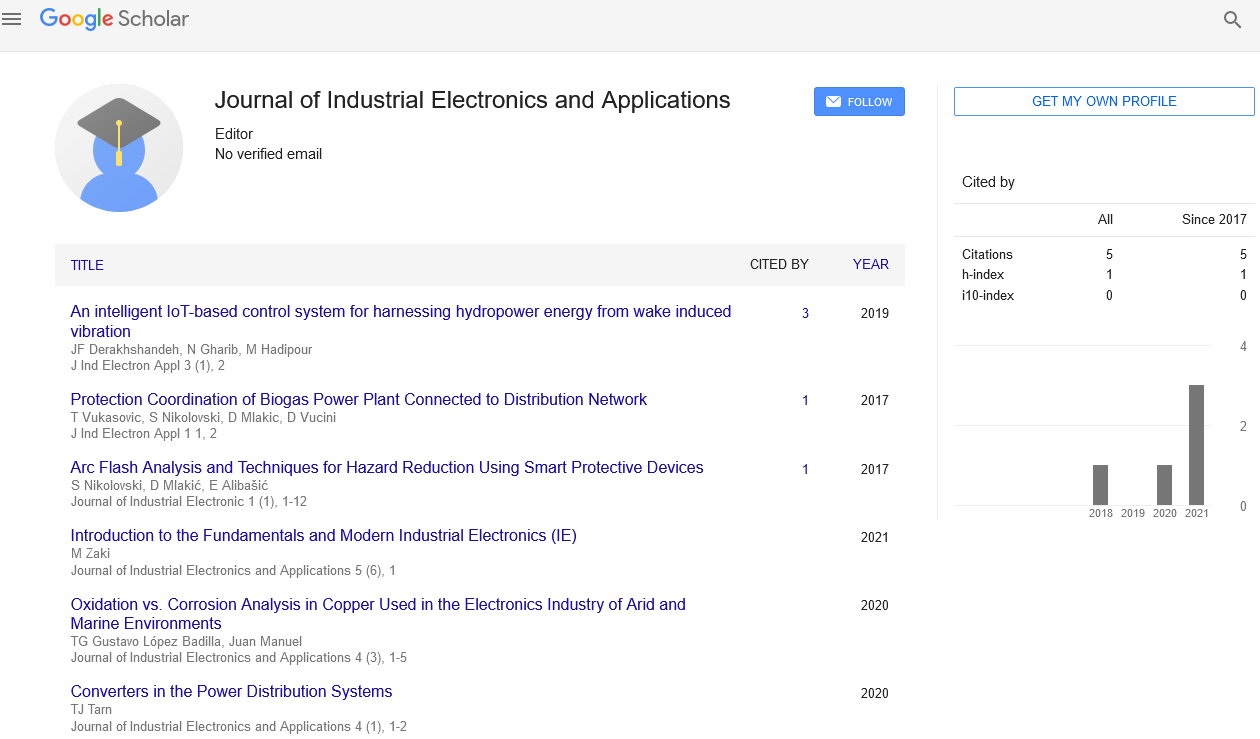Commentary, J Indelectronappl Vol: 5 Issue: 4
Headways in power semiconductor gadgets
Yuan Di*
Department of Energy and Automation, Technische Universität Berlin, Einsteinufer 11, Berlin, Germany
*Corresponding author: Yuan Di, Department of Energy and Automation, Technische Universität Berlin, Einsteinufer 11, Berlin, Germany; E-mail: yuandi@tu-berlin.de
Received date: 01 July, 2021; Accepted date: 10 July, 2021; Published date: 25 July, 2021
Keywords: semiconductor gadgets
Introduction
Force gadgets are the use of strong state hardware to the control and transformation of electric force. The main high force electronic gadgets were made utilizing mercury-bend valves. In present day frameworks, the transformation is performed with semiconductor exchanging gadgets like diodes, thyristors, and power semiconductors, for example, the force MOSFET and IGBT. Rather than electronic frameworks worried about transmission and preparing of signs and information, in power gadgets considerable measures of electrical energy are handled. An AC/DC converter (rectifier) is the most common force gadgets found in numerous buyer electronic gadgets, for example TVs, PCs, battery chargers, and so forth the force range is regularly from many watts to a few hundred watts. In industry, a typical application is the variable speed drive (VSD) that is utilized to control an enlistment engine. The force scope of VSDs begins from a couple hundred watts and end at several megawatts. Force electronic gadgets might be utilized as switches, or as intensifiers. An optimal switch is either open or shut thus disperses no force; it withstands an applied voltage and passes no current, or passes any measure of current with no voltage drops. Semiconductor gadgets utilized as switches can inexact this optimal property thus most force electronic applications depend on turning gadgets on and off, which makes frameworks extremely proficient as very little force is squandered in the switch. On the other hand, on account of the enhancer, the current through the gadget fluctuates consistently as indicated by controlled information. The voltage and current at the gadget terminals follow a heap line, and the force dissemination inside the gadget is huge contrasted with the force conveyed with the heap. A moderately new class of inverters, called staggered inverters, has acquired broad premium. Typical activity of CSIs and VSIs can be named two-level inverters, because of the way that force switches interface with either the positive or to the negative DC transport. On the off chance that multiple voltage levels were accessible to the inverter yield terminals, the AC yield could more readily estimated a sine wave. It is consequently that staggered inverters, albeit more intricate and expensive, offer better. Headways in power semiconductor gadgets have cleared the way for fresher gadgets like silicon carbide, gallium nitride field impact semiconductors (FETs), and force diodes. These gadgets have predominant attributes as far as wide band hole that takes into consideration high-voltage activity, warm administration, and productivity. This has brought about boundless use of force hardware even in commotion touchy regions, supplanting the lossy direct force supplies and voltage controllers. The fundamental benefit of these gadgets is that they can withstand high voltage when contrasted with the silicon gadgets. In this manner, the frameworks can be planned with high-voltage capacities, which, thus, lessen the current and further develop productivity, for a similar ability to be conveyed. Moreover, working the gadgets at higher exchanging frequencies helps in lessening the size of latent parts, making the frameworks minimized. The capacity to deal with higher temperatures works on warm plans. Force gadgets has arisen as a significant area of electric force designing and shows its cozy relationship with different disciplines like semiconductor material science, circuit hypothesis, simple, and advanced hardware. Alongside these, simple and advanced control frameworks, electrical machines and force frameworks, electromagnets and electrical machines, and so on. The converter gives ac or dc electric force as indicated by the heap with variable voltage and recurrence. Here we have said that the electric force at the yield is reliant upon the heap and the explanation for this is the point at which the heap is dc engine then the converter gives yield as customizable dc voltage. However, assume we have a threestage acceptance engine at the heap then the yield of the converter will be customizable ac voltage. The converter gives ac or dc electric force as per the heap with variable voltage and recurrence. Here we have said that the electric force at the yield is subject to the heap and the explanation for this is the point at which the heap is dc engine then the converter gives yield as movable dc voltage. Yet, assume we have a three-stage enlistment engine at the heap then the yield of the converter will be customizable ac voltage.
 Spanish
Spanish  Chinese
Chinese  Russian
Russian  German
German  French
French  Japanese
Japanese  Portuguese
Portuguese  Hindi
Hindi 